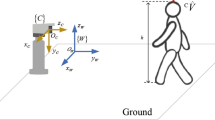Abstract
In this paper, a new way for a robust object tracking which based on somatosensory system tracking process is presented. When an object moves on the skin, it stimulates sensory receptors. Then, human can define object location at any time as well as its path. This perception is made by stimulation of the mechanoceptors. In this proposed approach, initially selected points named motionreceptors are fixed on the scene. Firstly, the tracker detects moving objects and represents them as points. Secondly, the tracker finds an association between objects and new detected zones. This association is done by calculating the degree of similarity between stimulated motionreceptors by new zones and objects. Then, it attributes new zones detected in motion to objects. Stimulated motionreceptors are points of the scene that are linked by a segment with points of objects or zones in the Delaunay triangulation. Finally, it updates objects position each time. Our approach was applied to some videos.
















Similar content being viewed by others
Explore related subjects
Discover the latest articles, news and stories from top researchers in related subjects.References
Brulin, M., Nicolas, H., & Maillet, C. (2010, November 14-17). Video surveillance traffic analysis using scene geometry. Pacific-Rim Symposium on Image and Video Technology (PSIVT) (pp.:450-455). Singapore: IEEE. doi:10.1109/PSIVT.2010.82
Caillette F, Howard T (2004). Real-time markerless human body tracking using colored voxels and 3-D blobs. International Symposium on Mixed and Augmented Reality (ISMAR). IEEE, Arlington (pp. 266–267). doi:10.1109/ISMAR.2004.50
De Berg M, van Kreveld M, Otfried C, Overmars M (2008) Computational geometry algorithms and applications, 3rd edn. Springer, Berlin. ISBN 978-3642096815
Emilio M, Andrea C (2011) Video tracking theory and practice. Wiley, UK. ISBN 978-0-470-74964-7
Garcia V, Debreuve E, Barlaud M (2007) Méthode de suivi d’objets basée sur des trajectoires temporelles de points d’intérêt. Colloques sur le Traitement du Signal et des Images (pp. 201–204). Troys: GRETSI, Groupe d’Etudes du Traitement du Signal et des Images. http://hdl.handle.net/2042/17477
Janos P (1993) New trends in discrete and computational geometry. Springer, Berlin. ISBN 978-3-540-55713-5
Jiang J, Yilmaz A (2014) Persistent tracking of static scene features using geometry. Comput Vis Image Underst 120:141–156. doi:10.1016/j.cviu.2013.10.009
Karan G, Anjali VK (2008) Implementation of an automated single camera object tracking system using frame differencing and dynamic template matching. Adv Comput Inform Sci Eng. pp 245–250
Koohi M, Narghi M, Shakey A (2011). An algorithm for object tracking based on adaptive triangle shape mesh estimation method. Canadian Conference on Electrical and Computer Engineering (CCECE) (pp. 354–359). IEEE, Niagara falls. doi:10.1109/CCECE.2011.6030472
Lederman SJ (1997) Skin and touch. Encyclopedia of human biology, second edition, 8. Academic Press, San Diego. ISBN: 9780122269707
Lixin F, Riihimaki M, Kunttu I (2010) A feature-based object tracking approach for real-time image processing on mobile devices. IEEE International Conference on Image Processing (ICIP) IEEE, Hong Kong (pp.3921–3924). doi:10.1109/ICIP.2010.5651003
Marieb EN, Hoehn K (2006). Human anatomy and physiology 7th Edition (Study Guide). Pearson-Benjamin Cummings, USA. ISBN: 978-0805373059
OpenCV developper team (2014) Motion analysis and object tracking. http://docs.opencv.org/modules/video/doc/motion_analysis_and_object_tracking.html
Prabhakar N, Vaithiyanathan V, Sharma AP, Singh A, Singhal P (2012) Object tracking using frame differencing and template matching. Res J Appl Sci Eng Technol 4(24):5497–5501
Preparata FP, Shamos MI (1985) Computational geometry an introduction. Springer, New York. ISBN 978-1-4612-1098-6
Quan W, Yang L, Chandroutie S (2010) Tracking based 3D visualization from 2D videos. http://www.ecse.rpi.edu/sites/sampl/quan/files/projects/Tracking%20Based%203D%20Visualization%20from%202D%20Videos.pdf
Radke RJ, Andra S, Al-Kofahi O, Roysam B (2004) Image change detection algorithms: a systematic survey. IEEE Trans Image Process 14(3):294–307
Remi T, Bernard M (2007) Probabilistic matching algorithm for keypoint based object tracking using a delaunay triangulation. International Workshop on Image Analysis for Multimedia Interactive Services (WIAMIS) (pp.17). IEEE, Santorini doi:10.1109/WIAMIS.2007.69
Rod RS, Trent DS, Philip T (2002) Essentials of anatomy and physiology, Fourth Edition. McGrow-Hill, New York. ISBN: 978-0-07-027260-6
Rod RS, Trent DS, Philip T (2007) Anatomy and physiology (8th edition). McGrow-Hill, New York. ISBN: 978–0–07–296557–5
Seizova-Cajic T, Taylor JL (2014) Somatosensory space abridged: rapid change in tactile localization using a motion stimulus. PLOS ONE 9:1–10
Yilmaz A (2011) Kernel-based object tracking using asymmetric kernels with adaptive scale and orientation selection. Mach Vis Appl 22(2):255–268. doi:10.1007/s00138-009-0237-4
Yilmaz A, Javed O, Shah M (2006) Object tracking a survey. ACM Comput Surv 4:38. doi:10.1145/1177352.1177355
Zu K (2006) Realtime obstacle detection and tracking based on constrained delaunay triangulation. Intelligent Transportation Systems Conference (ITSC) IEEE, Toronto. (pp. 548–553). doi:10.1109/ITSC.2006.1706798
Author information
Authors and Affiliations
Corresponding author
Rights and permissions
About this article
Cite this article
Abdelkrim, M.T., Merouani, H.F. & Benhammadi, Z. Object tracking based on the somatosensory system. Evolving Systems 6, 167–175 (2015). https://doi.org/10.1007/s12530-014-9120-2
Received:
Accepted:
Published:
Issue Date:
DOI: https://doi.org/10.1007/s12530-014-9120-2




